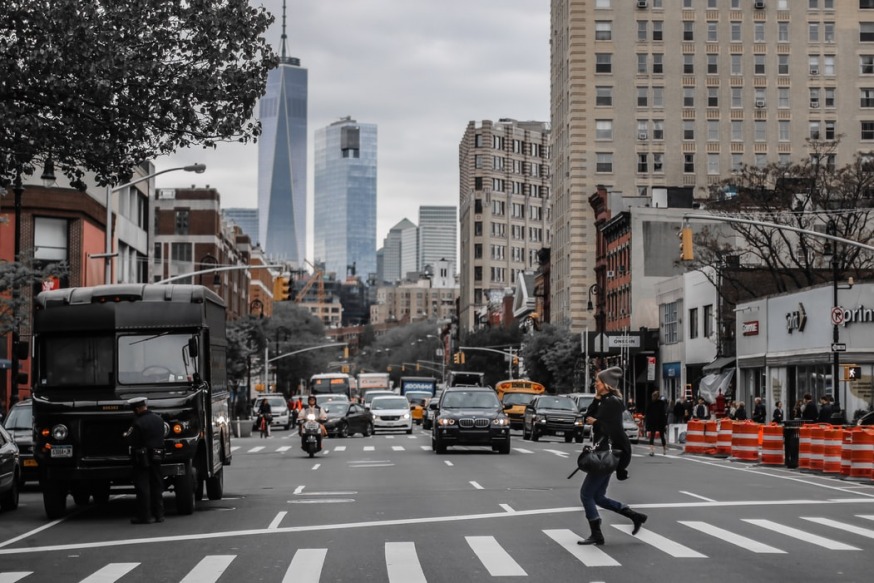
Drivers who enter Manhattan below 60th Street will be subject to a toll when the congestion pricing program goes into effect (unSplash)
Aug. 30, 2021 By Christian Murray
The public will get a chance in September to weigh in on the state’s plan to charge motorists a toll to enter Manhattan below 60th Street.
The MTA announced last week that it is holding 13 virtual meetings between mid-September and mid-October where it will discuss its congestion pricing plan that involves creating a tolling zone below 60th Street in Manhattan.
The plan will affect commuters throughout the Tri-state area—so 10 of the 13 meetings will be targeted to geographic regions, such as New Jersey, Connecticut and the outer boroughs. There will also be three meetings that will focus on the plan’s impact on minority and low-income communities.
The MTA says that congestion pricing is needed to address traffic gridlock and to bring in much-needed revenue in order to modernize and upgrade the subway and bus system. MTA officials say they could raise $15 billion through bonds based on the projected revenue.
The details as to how much it would cost per car or truck to enter the tolling zone has yet to be determined. The state legislature approved an overarching plan in 2019.
The public meeting schedule was announced a week after the federal government gave the MTA the approval it needed to start the environmental review process—a process mandated by federal law that requires agencies to examine the potential social and environmental impacts of such a project.
Feedback from the meetings will be part of environmental statement.
The plan is unlikely to go into effect until the end of 2023, officials say, since the MTA anticipates that the environmental review process will take 16 months and then the plan could take a year to implement.
While most Queens officials are in favor of congestion pricing, the plan has received some pushback. Elected officials in the eastern section of the borough have not embraced it with the same enthusiasm, arguing that it is unfair to their constituents who depend on cars given the lack of public transportation options.
The MTA and its allies argue that the plan will ease traffic and improve the transit system. They are urging the public to participate in the meetings.
“This is the first congestion pricing program in the United States, and it’s important that the public have an opportunity to learn about the proposal and to be able to weigh in,” said Janno Lieber, Acting MTA Chair & CEO. “We are committed to getting this project done quickly while providing the public real transparency throughout the process.”
10 Regional Public Meetings—Schedule
To register to speak, the public is advised to visit the MTA’s new Central Business District Tolling web portal at new.mta.info/project/CBDTP. The hearings will be held virtually at these dates and times:
- Thursday, Sept. 23, 10 a.m. to noon: The Bronx, Brooklyn, Queens, and Staten Island
- Thursday, Sept. 23, 6-8 p.m.: Manhattan Central Business District (60th Street and below)
- Friday, Sept. 24, 10 a.m. to noon: New Jersey
- Wednesday, Sept. 29, 10 a.m. to noon: Northern New York City Suburbs
- Wednesday, Sept. 29, 6-8 p.m.: Long Island
- Thursday, Sept. 30, 6-8 p.m.: The Bronx, Brooklyn, Queens, and Staten Island
- Friday, Oct. 1, 1-3 p.m.: Connecticut
- Monday, Oct. 4, 6-8 p.m.: New Jersey
- Tuesday, Oct. 5, 6-8 p.m.: Northern New York City Suburbs
- Wednesday, Oct. 6, 6-8 p.m.: Manhattan Outside the Central Business District (61st Street and above)
Three virtual meetings will be held, focused on environmental justice communities located respectively in New York, New Jersey, and Connecticut, though anyone may register to attend any or all of these:
- Thursday, Oct. 7, 6-8 p.m.: New York
- Tuesday, Oct. 12, 6-8 p.m.: New Jersey
- Wednesday, Oct. 13, 6-8 p.m.: Connecticut
One Comment

MTA FORECAST OF $15 BILLION IN CONGESTION PRICING REVENUE WAS ALWAYS WISHFUL THINKING
Details of who will pay what can never be resolved until the Traffic Mobility Review Board board is established’
This process is politically sensitive. Congestion Pricing may not kick in until January 2023. Even this date may not hold. This was suppose to have raised $15 of the $51 billion MTA 2020 – 2024 Five Year Capital Plan. The MTA recently stated that they need 16 months rather than four months as previously announced just to complete the federal NEPA environmental review process. You can’t capture five years of toll revenues estimated to be $1 billion per year (leveraged to raise $15 billion in support of MTA’s $51 billion 2020-2024 five year capital plan) when you implement the program three years after 2020.
Late start for implementation, downturn in the economy, more people telecommuting full and part time along with a series of discounts and exemptions to tolls will result in billions of lost anticipated revenue.
(Larry Penner is a transportation advocate, historian and writer who previously worked for the Federal Transit Administration Region 2 New York Office).